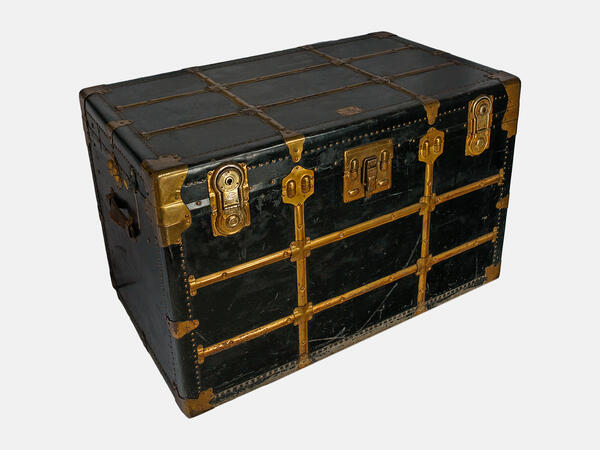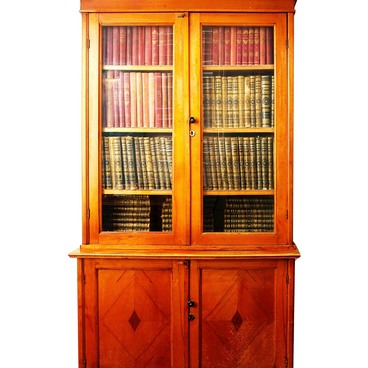This trunk, used for storing and transporting belongings while traveling, was manufactured in the USA at the beginning of the 20th century. The lightweight and sturdy wooden construction is covered in leather. The trunk has three metal locks and two leather handles on the sides. It is reinforced with white bronze metal strips, staples and plates. The lid has a metal nameplate that features the company’s symbol — a globe — and the inscription “Guaranteed Overland Trunk NY USA”.
The Sergeyev-Tsensky couple traveled with this trunk. The first time Sergey and Khristina traveled together, they went to the Caucasus 10 days after Sergeyev-Tsensky met Gorky, in July 1928. At the time, the writer was working on a play about Mikhail Lermontov. He later recalled, “I mainly wished to see the place of Lermontov’s duel with Martynov and the house in Pyatigorsk where their quarrel took place… By the way, this trip provided me with the subject matter for the story ‘How One Tries to Escape Time’. It also brought me immense joy in the face of Gorky, whom I met unexpectedly in Vladikavkaz.”
From 1928 to 1934, the writer and his wife traveled all over the country, visiting Moscow, Kharkov, Dnepropetrovsk, Zaporozhye, Kramatorsk, and Kerch. Sergeyev-Tsensky often came to Moscow. In 1929, he held meetings in the capital with Mikhail Kalinin, Valerian Kuybyshev, Maxim Gorky, Anton Makarenko, and Alexey Tolstoy, as well as established business relationships with the magazine editors Vyacheslav Polonsky and Alexander Voronsky, employees of publishing houses, and theaters.
But particularly impressive were the trips that the Sergeyev-Tsenskys took in 1932–1934 to visit the construction sites of the first Soviet five-year plan: the Dnieper Hydroelectric Station, the Kharkov Tractor Plant, the Kramatorsk and Kerch Ironworks, and the Dnepropetrovsk Coke and Chemical Plant. While there, the couple met with shock workers, engineers and technicians. Sergeyev-Tsensky was very much impressed with the incredible effort and the unprecedented scale of construction.
Since 1937, the Sergeyev-Tsenskys spent spring, summer and autumn in Crimea and went to Moscow for the winter. They returned to Alushta in early spring when almond trees were in bloom.


